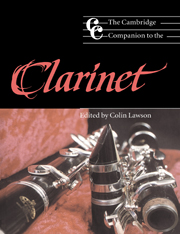Book contents
- Frontmatter
- 1 Single reeds before 1750
- 2 The development of the clarinet
- 3 The clarinet family
- 4 The development of the clarinet repertoire
- 5 Players and composers
- 6 The mechanics of playing the clarinet
- 7 Teaching the clarinet
- 8 Playing historical clarinets
- 9 The professional clarinettist
- 10 The contemporary clarinet
- 11 The clarinet in jazz
- 12 The clarinet on record
- Notes
- Appendices
- Select bibliography
- Index
4 - The development of the clarinet repertoire
Published online by Cambridge University Press: 28 September 2011
- Frontmatter
- 1 Single reeds before 1750
- 2 The development of the clarinet
- 3 The clarinet family
- 4 The development of the clarinet repertoire
- 5 Players and composers
- 6 The mechanics of playing the clarinet
- 7 Teaching the clarinet
- 8 Playing historical clarinets
- 9 The professional clarinettist
- 10 The contemporary clarinet
- 11 The clarinet in jazz
- 12 The clarinet on record
- Notes
- Appendices
- Select bibliography
- Index
Summary
1750–1800
The clarinet's full and penetrating sound made it a popular choice for outdoor ensembles and bands; to realise just how popular, one need only glance at the Harmonie listings in the first edition of Whistling's Handbuch der Musikalischen Literatur, which devotes several pages to works for wind band published before 1816. Its uniquely controllable volume made it equally useful for the chamber or concert hall. While the Mannheim court orchestra was not the first to adopt the clarinet as an essential instrument, the orchestra's high standard of performance and its resultant good reputation played a vital part in the adoption of the instrument elsewhere. The repertoire of the instrument's first century included many concertos designed to display its capabilities. In its early days, concertos and orchestral works mainly utilised the clarinet register and the notes immediately above it; the clarinet parts in Abel's Symphony Op. VII/6 (formerly attributed to Mozart as K18) are typical and seldom venture below the throat notes in either part.
Franz Anton Hoffmeister, Mozart's publisher and a popular composer in his own right, wrote concertos, sonatas and pieces for various wind ensembles. While (as is probably true of many composers whose lists of works number hundreds rather than dozens) he could not be accused of originality, his music is competently written, agreeable to play and comfortable for audiences. There are moments of genuine quality; one feels that he scarcely deserves Fétis's unkind comment ‘O, sterile fécondité!’
- Type
- Chapter
- Information
- The Cambridge Companion to the Clarinet , pp. 75 - 91Publisher: Cambridge University PressPrint publication year: 1995



